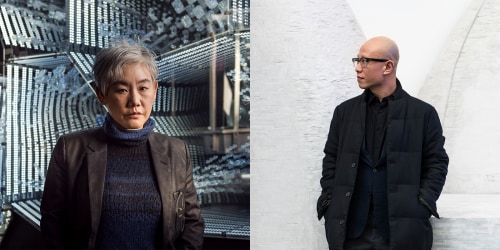
Lehmann Maupin congratulates Lee Bul and Liu Wei on their inclusion in the 58th Venice Biennale. Both artists, represented by the gallery since 2007 and 2012 respectively, will contribute two works to the Ralph Rugoff-curated May You Live In Interesting Times. Works include Lee Bul’s Scale of Tongue (2017–2018) and Liu Wei’s Microworld (2018). In a recent statement, Rugoff explained the International Art Exhibition “will highlight a general approach to making art and a view of art’s social function as embracing both pleasure and critical thinking. The Exhibition will focus on the work of artists who challenge existing habits of thought and open up our readings of objects and images, gestures and situations.”
Lee Bul (b. 1964, Yeongju; lives and works in Seoul) works across a diverse range of media—from drawing, sculpture, and painting to performance, installation, and video—in examining the intricacies of shared human consciousness and the myths and folklore that accompany history. She investigates the liminal space between binaries such as the individual and the collective, and contradictory feelings such as isolation and claustrophobia. Her installations and sculptures explore universal themes such as the utopian desire to achieve perfection through technological advances, and the dystopic suspicions and failures that often result. For Lee Bul, humankind’s fascination with technology ultimately refers to our preoccupations with the human body and our desire to transcend flesh in pursuit of immortality.
Liu Wei (b. 1972, and lives and works in Beijing, China) explores 21st century socio-political concepts such as the contradictions of contemporary society and the transformation of developing cities and the urban landscape. In many of his sculptural and installation works, he uses found materials that are re-contextualized to draw new meanings out of the materials from which they are made. He frequently uses geometric and architectural forms in his work as a reference to his urban surroundings.
Lee Bul portrait: Photo by Klaus Vyhnalek, courtesy Swarovski Kristallwelten. Liu Wei portrait: Photo by Dora Tang
立木畫廊祝賀李昢和劉韡參與第58屆威尼斯雙年展。立木畫廊分別於 2007 年和 2012 年代理這兩名藝術家。於是次雙年展中,兩名藝術家將會提供兩件作品給雷夫·魯格夫(Ralph Rugoff)策劃的 May You Live In Interesting Times 展覽 ,作品包括李昢的 Scale of Tongue (2017–2018)及劉韡的 Microworld (2018)。在最近的一份聲明中,魯格夫解釋是次雙年展將會強調藝術作為娛樂大眾和激發批判性思考的兩種社會功能。展覽會聚焦於突破常規和既定思維的藝術家作品,繼而刺激觀眾對物體和圖像,形體和情境的解讀和思考。
李昢(1964年生於韓國瀛洲;於韓國首爾定居)從事於各種媒體 – 從繪畫、雕塑、表現藝術,裝置和視頻 - 透過媒體審視人類意識的複雜性,以及歷史裏的神話和民間傳說。她研究二元性之間的邊界空間如個人和集體,以及人類矛盾的情感,如孤立和幽閉恐懼癥。她的裝置和雕塑探索一些大命題,例如通過科技進步實現烏托邦,以及經常導致對敵托邦的質疑和失敗結果。對李昢來說,人類迷戀科技往往皆因他們對人體的吸引和追求永生的欲望。
按此查看更多有關李昢及立木畫廊於巴塞爾藝術展香港展會「策展角落」和「藝聚空間」中的展覽。
劉韡(1972年生於和居住於中國北京)致力探索中國21世紀後毛澤東時代的社會和政治觀念,如當代社會的矛盾和發展中城市的景觀轉變。他的許多繪畫、影像、裝置、素描及雕塑作品中運用找到的物料重構新的意義。他的作品經常運用地理和建築的形式展現出他心目中的城市環境。
按此查看更多有關劉韡於立木畫廊的作品。
李昢照片由 Klaus Vyhnalek 拍攝,Swarovski Kristallwelten 提供;劉韡照片由 Dora Tang 拍攝
리만머핀 소속작가 이불(Lee Bul)과 리우 웨이(Liu Wei)가 제 58회 베니스비엔날레 본전시에 참여한다. 각각 2007년과 2012년부터 본 갤러리 소속으로 활동하고 있는 두 작가는 이번 베니스 비엔날레의 총감독 랄프 루고프(Ralph Rugoff, 現 런던 헤이워드 갤러리 디렉터)가 기획한 May You Live In Interesting Times에서 작품을 선보일 예정이며, 전시작은 작가 이불의 Scale of Tongue(2017-2018)와 리우 웨이의 Microworld(2018)이다. 최근 루고프 감독은 이번 전시에 대해 “즐거움과 비판적 사고를 수용하여 예술을 만드는 일반적인 접근과 예술의 사회적인 기능에 대한 관점을 강조할 것이며, 기존의 사고방식에 도전하여 오브제, 이미지, 제스쳐 그리고 환경에 대한 우리의 이해를 확장시키는 작가의 작업에 초점을 맞출 것이다.” 라고 언급한 바 있다.
작가 이불(1964년 경북 영주 출생, 현재 서울에서 거주하며 작업)은 조각, 회화, 드로잉, 퍼포먼스, 설치, 그리고 비디오까지 다양한 장르를 자유롭게 넘나들며 역사에 수반되는 복잡한 인류의 의식, 신화 및 민속에 대해 탐구하고, 개인과 집단 혹은 고립과 폐소공포증 같은 모순적인 감정에서 비롯된 이중성에 주목한다. 작가의 조각과 설치 작업은 기술의 진보를 통해 완벽을 성취하고자 하는 유토피아적 욕망, 그리고 종종 발생하는 근시안적인 의심과 실패 같은 보편적인 주제를 다룬다. 작가는 인류가 기술에 매료되는 것이 결국 인간의 몸에 대한 선입견이자 육체를 초월하여 불멸을 이루고자하는 우리의 욕망이라고 여긴다.
2019 홍콩아트바젤의 Kabinett과 Encounters 섹터에 나올 작가 이불의 작품 정보는 여기에서 확인할 수 있다.
작가 리우 웨이(Liu Wei, 1972년생, 중국 베이징에서 거주하며 작업)는 현대사회의 모순과 도시환경 개발에 따른 변화 등 21세기의 사회 정치적 개념을 탐구한다. 작가는 본래 재료가 갖고있는 성질로부터 새로운 의미를 부여하기위해 재맥락화한 오브제를 사용하여 조각과 설치작업을 한다. 또한 그는 작업에 기하학적이고 건축적인 형태를 자주 등장시키는데, 이는 작가가 살아가는 도시환경을 나타낸 것이다.
작가 리우웨이의 지난 리만머핀 전시는 여기에서 확인할 수 있다.
이불 이미지: 사진 Klaus Vyhnalek, Swarovski Kristallwelten제공. 리우 웨이 이미지: 사진 Dora Tang
